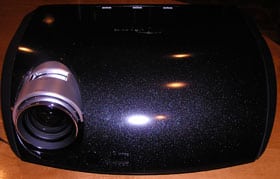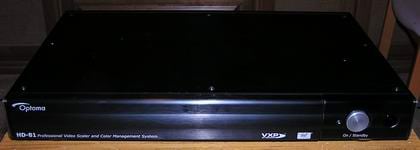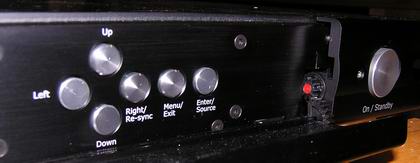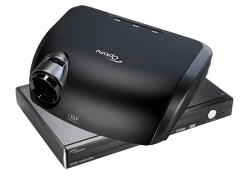As noted above, the HD81-LV comes in two pieces, the projector itself, and its outboard Gennum processor. In addition we reviewed the HD81-LV with, and without the optional anamorphic lens. First, the Projector: The HD81-LV is finished in a shiney black cabinet with a fine silver speckling throughout, with chrome trim on the lens. The outboard processor box is finished in basic black, with silver buttons (most - the control panel - are hidden behind a hinged door). Facing the front of the projector, there is a large lens, mounted toward the left side. If you are ceiling mounting, you'll need to do your measurements to compensate for the lens being off center, as you would with any other home theater projector without a center mounted lens. Throw distances: The HD81-LV (without anamorphic lens), can be placed as close as 13 feet, 6 inches, or as far back as 16 feet 2 inches, if you are filling a 100" diagonal, 16:9 screen. You can figure out the throw distances for any other screen size, simply, from these numbers. For example, if you went with a 120" screen, then, both the closest and furthest distances would increase by 20% respectively.
The outer ring of the lens handles the manual focus. Behind that, is a recessed area (at the top), on the lens barrel, for adjusting the manual 1.2:1 zoom lens. Also found in the front, low and almost centered (next to the DLP insignia), is the front Infra-Red sensor for the remote control.
There are two adjustable front feet, mounted on the left and right sides. There is a "press to release" button for each one, to allow users to adjust the leg height.
Venting is out the sides. This technically makes rear shelf mounting the projector possible, although other aspects of the projector make it unlikely that anyone will actually shelf mount it.
Moving to the top of the projector, not much to see, only three indicator lights on a bar across the back top. One indicator for Power, one each for Temperature, and Lamp.
That takes us to an almost empty back panel, (shown above), found on the back of the HD81 projector. It's pretty sparse, since everything basically plugs into the outboard processor. The processor then connects to the HD81 itself by way of two cables. The first is an HDMI cable input, and the second, and RS-232 for control. There is also a service port, for upgrades (I assume), etc. There is also the usual power receptacle. That's it! Everything else is on the Gennum VXP scaler/processor.
I must also note that the HD81 DLP projector has two rear feet, which are screw thread adjustable.
That brings us to taking a close look at the Gennum XVP processor itself (It bares the Optoma logo).
The box itself is wide, suitable for rack mounting with an adapter. It is about 2 inches tall, and is finished in black. From the front: Only the large power button toward the far right (and the IR sensor) is visible, with the front hinged door closed. Open it up, and you will find a basic control panel near the center. It offers (from the right), the usual Source button, which doubles as the Enter button when menus are in use. Next to the left is the Menu button. Further left are four silver buttons in the usual diamond layout, for left/right/up/down functionality when navigating the menus.
Far left on the HD81's processor (not shown), are three inputs, allowing for easy, fast hookup of temporary devices such as a camcorder or computer. The inputs are: Composite video (RCA jack), S-Video (DIN plug), and Analog Computer (VGA) - (HD15 connector).
That takes us to the rear of the Gennum processor, which is jam packed with inputs. This allows the HD81 to hook up to far more sources than any other 1080p projector in its price range. The only less expensive projector I can think of with outboard processing like the HD81, is one of the two versions of Epson's new Pro Cinema 810. The Epson too is loaded with inputs, but it is a lower resolution, 720p projector, so not a close competitor.
The HD81-LV's processor supports the following:
HDMI inputs: 3 standard HDMI inputs (all HDCP compliant), plus an HDMI input if you bring in a signal from an AV receiver equipped to output HDMI.
Component Video inputs: Two sets, each with separate R,G,B (RCA jack) connectors.
S-Video inputs: (standard DIN connectors)
Composite inputs: (standard RCA jack)
BNC inputs: 2 sets of 5 BNC connectors each, which can be used for analog computer inputs, or for additional Component video sources. Add all of that up, and you have a whopping 8 high resolution (computer, component and digital - HDMI) inputs, plus the four lower resolution ones (the composite and S-video).
Other input/outputs: There are two RS-232 connectors. One is mandatory, and connects to the projector (Optoma provides a short cable, and an extension, but in most mounting situations, you will need longer cables). The second one can be connected to external control devices, such as a room controller (ie. Crestron, AMX...), computer, etc, for remotely controlling the projector functions.
There is also an HDMI output to an AV receiver. This I found interesting. If you have an AV receiver with a sufficient number of HDMI inputs, normally you would let the Receiver handle the source switching between the various HDMI inputs, and then feed that to the projector's processor. If however, your receiver has only one HDMI input, or simply not enough of them to let it do your switching, you can run the HDMI sources to the Gennum processor, and have a single HDMI output to the AV receiver, which will pass along the audio information. (A big difference between HDMI and DVI, is that HDMI cables carry the audio as well as the picture). By connecting the output to the AV receiver, you are passing the sound portion of the data from your DVD player, Cable/Satellite box, etc., to the receiver, while the image portion is processed and sent to the projector. That pretty much covers the outboard processor for the HD81-LV.
Lastly, the processor box has 12 volt triggers for motorized screen control. A look at the manual indicates that the trigger can be programmed. This is ideal for those with masking screens (that basically bring down cloth or other method to change the visible surface area). You might use a masking screen in conjunction with (or without) an anamorphic lens. Once set up, the processor box would control the screen to use the right masking for the aspect ratio of the content you are watching. Cool!
The HD81-LV itself has no power switch. The Gennum processor turns on the projector when you hit the power switch on the processor, or use the remote control to power up.
Optoma HD81-LV Optional Anamorphic Lens
I received the HD81-LV and processor box in one shipping box, and their optional Anamorphic lens and motor drive in a separate box. The $3999 lens and motorized sled option allows you to view full Cinemascope movies (2.35:1) without any letter boxing. It does, however affect the throw distances. I will discuss in more depth in the general performance section.
Time to check out the HD81-LV's overall image quality.







